Page version status
This is an accepted version of this page
| Caracal | |
|---|---|
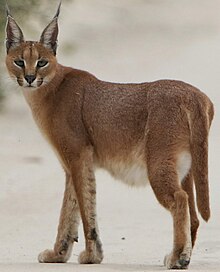
| |
| Caracal in Kgalagadi Transfrontier Park | |
| Conservation status | |
 Least Concern (IUCN 3.1) | |
| CITES Appendix I (CITES) | |
| Scientific classification | |
| Domain: | Eukaryota |
| Kingdom: | Animalia |
| Phylum: | Chordata |
| Class: | Mammalia |
| Order: | Carnivora |
| Suborder: | Feliformia |
| Family: | Felidae |
| Subfamily: | Felinae |
| Genus: | Caracal |
| Species: | C. caracal |
| Binomial name | |
| Caracal caracal (Schreber, 1776) | |
| Subspecies | |
|
See text | |

| |
| Distribution of caracal, 2016 | |
| Synonyms | |
List
| |
The caracal (Caracal caracal) (/ˈkærəkæl/) is a medium-sized wild cat native to Africa, the Middle East, Central Asia, and arid areas of Pakistan and northwestern India. It is characterised by a robust build, long legs, a short face, long tufted ears, relatively short tail, and long canine teeth. Its coat is uniformly reddish tan or sandy, while the ventral parts are lighter with small reddish markings. It reaches 40–50 cm (16–20 in) at the shoulder and weighs 8–19 kg (18–42 lb). It was first scientifically described by German naturalist Johann Christian Daniel von Schreber in 1776. Three subspecies are recognised.
Typically nocturnal, the caracal is highly secretive and difficult to observe. It is territorial, and lives mainly alone or in pairs. The caracal is a carnivore that typically preys upon birds, rodents, and other small mammals. It can leap higher than 3.0 m (9.8 ft) and catch birds in midair. It stalks its prey until it is within 5 m (16 ft) of it, after which it runs it down and kills it with a bite to the throat or to the back of the neck. Both sexes become sexually mature by the time they are one year old and breed throughout the year. Gestation lasts between two and three months, resulting in a litter of one to six kittens. Juveniles leave their mothers at the age of nine to ten months, though a few females stay back with their mothers. The average lifespan of captive caracals is nearly 16 years.
Etymology
The name 'caracal' was proposed by Georges Buffon in 1761 who referred to its Turkish name 'Karrah-kulak' or 'Kara-coulac', meaning 'black ear'. The 'lynx' of the Greeks and Romans was most probably the caracal, and the name 'lynx' is sometimes still applied to it, but the present-day lynx proper is a separate genus. The caracal is also known as desert lynx and Persian lynx.
Taxonomy and phylogeny
Felis caracal was the scientific name used by Johann Christian Daniel von Schreber in 1776 who described a caracal skin from the Cape of Good Hope. In 1843, John Edward Gray placed it in the genus Caracal. It is placed in the family Felidae and subfamily Felinae.
In the 19th and 20th centuries, several caracal specimens were described and proposed as subspecies. Since 2017, three subspecies have been recognised as valid:
- Southern caracal (C. c. caracal) (Schreber, 1776) – occurs in Southern and East Africa
- Northern caracal (C. c. nubicus) (Fischer, 1829) – occurs in North and West Africa
- Asiatic caracal (C. c. schmitzi) (Matschie, 1912) – occurs in Asia
Phylogeny
Results of a phylogenetic study indicates that the caracal and the African golden cat (Caracal aurata) diverged between 2.93 and 1.19 million years ago. These two species together with the serval (Leptailurus serval) form the Caracal lineage, which diverged between 11.56 and 6.66 million years ago. The ancestor of this lineage arrived in Africa between 8.5 and 5.6 million years ago.
The relationship of the caracal is considered as follows:
| |||||||||||||||||||||||||||||||||||||||||||||||||||||||||||||||||||||||||||||||
Characteristics

The caracal is a slender, moderately sized cat characterised by a robust build, a short face, long canine teeth, tufted ears, and long legs. It reaches nearly 40–50 cm (16–20 in) at the shoulder. The tan, bushy tail extends to the hocks. The caracal is sexually dimorphic; the females are smaller than the males in most bodily parameters.
The prominent facial features include the 4.5 cm (1.8 in) long black tufts on the ears, two black stripes from the forehead to the nose, the black outline of the mouth, the distinctive black facial markings, and the white patches surrounding the eyes and the mouth. The eyes appear to be narrowly open due to the lowered upper eyelid, probably an adaptation to shield the eyes from the sun's glare. The ear tufts may start drooping as the animal ages. The coat is uniformly reddish tan or sandy, though black caracals are also known. The underbelly and the insides of the legs are lighter, often with small reddish markings. The fur, soft, short, and dense, grows coarser in the summer. The ground hairs are denser in winter than in summer. The length of the guard hairs can be up to 3 cm (1.2 in) long in winter, but shorten to 2 cm (0.79 in) in summer. These features indicate the onset of moulting in the hot season, typically in October and November. The hind legs are longer than the forelegs, so the body appears to be sloping downward from the rump.
Male caracals measure in head-to-body length 78–108 cm (31–43 in) and have 21–34 cm (8.3–13.4 in) long tails; 77 male caracals ranged in weight between 7.2 and 19 kg (16 and 42 lb). The head-to-body length of females is 71–103 cm (28–41 in) with a tail of 18–31.5 cm (7.1–12.4 in); 63 females ranged in weight between 7 and 15.9 kg (15 and 35 lb).
The caracal is often confused with a lynx, as both cats have tufted ears. However, a notable point of difference between the two is that Lynx species are spotted and blotched, while the caracal shows no such markings on the coat. The African golden cat has a similar build as the caracal's, but is darker and lacks the ear tufts. The sympatric serval can be distinguished from the caracal by the former's lack of ear tufts, white spots behind the ears, spotted coat, longer legs, longer tail, and smaller footprints.
The skull of the caracal is high and rounded, featuring large auditory bullae, a well-developed supraoccipital crest normal to the sagittal crest, and a strong lower jaw. The caracal has a total of 30 teeth; the dental formula is 3.1.3.13.1.2.1. The deciduous dentition is 3.1.23.1.2. The canines are up to 2 cm (0.79 in) long and sharp. The caracal lacks the second upper premolars, and the upper molars are diminutive. The large paws have four digits in the hind legs and five in the fore legs. The first digit of the fore leg remains above the ground and features the dewclaw. The sharp and retractile claws are larger but less curved in the hind legs.
Distribution and habitat

In Africa, the caracal is widely distributed south of the Sahara, but considered rare in North Africa. In Asia, it occurs from the Arabian Peninsula, Middle East, Turkmenistan, Uzbekistan to western India. It inhabits forests, savannas, marshy lowlands, semideserts, and scrub forests, but prefers dry areas with low rainfall and availability of cover. In montane habitats such as in the Ethiopian Highlands, it occurs up to an elevation of 3,000 m (9,800 ft).
In Ethiopia's Degua Tembien massif, they can be seen along roads, sometimes as roadkills.
In the Emirate of Abu Dhabi, a male caracal was photographed by camera traps in Jebel Hafeet National Park in Al Ain Region, in spring 2019, the first such record since the mid-1980s.
In south-western Turkey, caracals are present in a wildlife reserve in the provinces of Antalya and Muğla that is regularly used for recreational and agricultural activities. However, they avoid humans and are active mostly at night. In Uzbekistan, caracals were recorded only in the desert regions of the Ustyurt Plateau and Kyzylkum Desert. Between 2000 and 2017, 15 individuals were sighted alive, and at least 11 were killed by herders.
In Iran, the caracal has been recorded in Abbasabad Naein Reserve, Bahram’gur Protected Area, Kavir National Park and in Yazd province.
In India, the caracal occurs in Sariska Tiger Reserve and Ranthambhore National Park. The Indian population may be under 100, and is thought extinct in 10 of the 13 Indian states it had historical populations in.
Ecology and behaviour
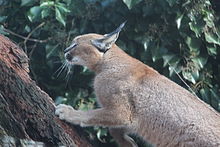
The caracal is typically nocturnal, though some activity may be observed during the day as well. However, the cat is so secretive and difficult to observe that its activity at daytime might easily go unnoticed. A study in South Africa showed that caracals are most active when the air temperature drops below 20 °C (68 °F); activity typically ceases at higher temperatures. A solitary cat, the caracal mainly occurs alone or in pairs; the only groups seen are of mothers with their offspring. Females in oestrus temporarily pair with males. A territorial animal, the caracal marks rocks and vegetation in its territory with urine and probably with dung, which is not covered with soil. Claw scratching is prominent, and dung middens are typically not formed. In Israel, males are found to have territories averaging 220 km (85 sq mi), while that of females averaged 57 km (22 sq mi). The male territories vary from 270–1,116 km (104–431 sq mi) in Saudi Arabia. In Mountain Zebra National Park, the home ranges of females vary between 4.0 and 6.5 km (1.5 and 2.5 sq mi). These territories overlap extensively. The conspicuous ear tufts and the facial markings often serve as a method of visual communication; caracals have been observed interacting with each other by moving the head from side to side so that the tufts flicker rapidly. Like other cats, the caracal meows, growls, hisses, spits, and purrs.
Diet and hunting

The caracal typically preys on mammals, which generally comprise at least 80% of its diet; and it also targets small Cercopithecidae monkeys and larger antelopes such as young kudu, impala, mountain gazelle, dorcas gazelle, Cape bushbuck, gerenuk, mountain reedbuck, Sharpe's grysbok and springbok. The remaining percentage is made up of lizards, snakes and insects. Rodents comprise a significant portion of its diet in western India. It tends to focus on the most abundant prey species. Occasionally, it consumes grasses and grapes, which help to clear the immune system and stomach of any parasites.
In South Africa, caracals prey on Cape grysbok, common duiker, bush vlei rats, rock hyrax and Cape hare. In areas where sheep and goat are farmed, caracals have also been documented preying on small livestock, but this is however only a small and seasonal portion of their diet when wild prey is scarce. Caracals are estimated to have caused about 11% of African penguin mortality in Simon's Town breeding colony between January 1999 and September 2021.
The caracals's speed and agility make it an efficient hunter, able to take down prey two to three times its size. The powerful hind legs allow it to leap more than 3 m (9.8 ft) in the air to catch birds on the wing. It can even twist and change its direction mid-air. It is an adroit climber. It stalks its prey until it is within 5 m (16 ft), following which it can launch into a sprint. While large prey such as antelopes are suffocated by a throat bite, smaller prey are killed by a bite on the back of the neck. Kills are consumed immediately, and less commonly dragged to cover. It returns to large kills if undisturbed. It has been observed to begin feeding on antelope kills at the hind parts. It may scavenge at times, though this has not been frequently observed.
Reproduction
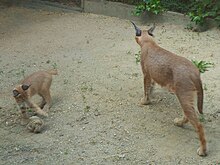
Both sexes become sexually mature by the time they are a year old; production of gametes begins even earlier at seven to ten months. However, successful mating takes place only at 12 to 15 months. Breeding takes place throughout the year. Oestrus, one to three days long, recurs every two weeks unless the female is pregnant. Females in oestrus show a spike in urine-marking, and form temporary pairs with males. Mating has not been extensively studied; a limited number of observations suggest that copulation, lasting nearly four minutes on an average, begins with the male smelling the areas urine-marked by the female, which then rolls on the ground. He then approaches and mounts her. The pair separate after copulation.
Gestation lasts about two to three months, following which a litter consisting of one to six kittens is born. Births generally peak from October to February. Births take place in dense vegetation or deserted burrows of aardvarks and porcupines. Kittens are born with their eyes and ears shut and the claws not retractable (unable to be drawn inside); the coat resembles that of adults, but the abdomen is spotted. Eyes open by ten days, but it takes longer for the vision to become normal. The ears become erect and the claws become retractable by the third or the fourth week. Around the same time, the kittens start roaming their birthplace, and start playing among themselves by the fifth or the sixth week. They begin taking solid food around the same time; they have to wait for nearly three months before they make their first kill. As the kittens start moving about by themselves, the mother starts shifting them every day. All the milk teeth appear in 50 days, and permanent dentition is completed in 10 months. Juveniles begin dispersing at nine to ten months, though a few females stay back with their mothers. The average lifespan of the caracal in captivity is nearly 16 years.
In the 1990s, a captive caracal spontaneously mated with a domestic cat in the Moscow Zoo, resulting in a felid hybrid offspring.
Threats
The caracal is listed as Least Concern on the IUCN Red List since 2002, as it is widely distributed in over 50 range countries, where the threats to caracal populations vary in extent. Habitat loss due to agricultural expansion, the building of roads and settlements is a major threat in all range countries. It is thought to be close to extinction in North Africa, critically endangered in Pakistan, endangered in Jordan, but stable in central and Southern Africa. Local people kill caracal to protect livestock, or in retaliation for its preying on small livestock. Additionally, it is threatened by hunting for the pet trade on the Arabian Peninsula. In Turkey and Iran, caracals are frequently killed in road accidents. In Uzbekistan, the major threat to caracal is killing by herders in retaliation for livestock losses. Guarding techniques and sheds are inadequate to protect small livestock like goats and sheep from being attacked by predators. Additionally, similarly to Ethiopia, heavy-traffic roads crossing caracal habitat pose a potential threat for the species.
Conservation
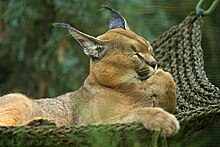
African caracal populations are listed under CITES Appendix II, while Asian populations come under CITES Appendix I. Hunting of caracal is prohibited in Afghanistan, Algeria, Egypt, India, Iran, Israel, Jordan, Kazakhstan, Lebanon, Morocco, Pakistan, Syria, Tajikistan, Tunisia, Turkey, Turkmenistan, and Uzbekistan. Caracals occur in a number of protected areas across their range.
In South Africa, the caracal is considered Least Concern, as it is widespread and adaptable to a variety of habitats. It is tolerant to human-dominated areas, although it has been persecuted for many decades. Farmers are encouraged to report sightings of caracals, both dead and alive, and livestock killed by caracals to the national Predation Management Information Centre.
The Central Asian caracal population is listed as Critically Endangered in Uzbekistan since 2009, and in Kazakhstan since 2010.
In culture
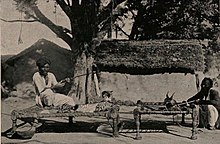
The caracal appears to have been religiously significant in the ancient Egyptian culture, as it occurs in paintings and as bronze figurines; sculptures are thought to have guarded the tombs of pharaohs. Embalmed caracals have also been discovered.
The caracal was esteemed for its ability to catch birds in flight and was used for coursing by Mughal emperors in India at least since the Delhi Sultanate. Chinese emperors used caracals as gifts. In the 13th and the 14th centuries, Yuan dynasty rulers bought numerous caracals, cheetahs (Acinonyx jubatus) and tigers (Panthera tigris) from Muslim merchants in the western parts of the empire in return for gold, silver, copper cash and silk. According to the Ming Shilu, the subsequent Ming dynasty continued this practice. Until the 20th century, the caracal was used in hunts of Indian rulers to hunt small game, while the cheetah was used for larger game. In those times, caracals were used to hunt bustards, francolins, and other game birds. They were also placed in arenas with flocks of pigeons and people would bet on which caracal would kill the largest number of pigeons. This probably gave rise to the expression "to put the cat among the pigeons". Its pelt was used for making fur coats.
See also
Notes
- Only populations of Asia. All other populations are included in Appendix II.
References
- ^ Avgan, B.; Henschel, P. & Ghoddousi, A. (2016) . "Caracal caracal". IUCN Red List of Threatened Species. 2016: e.T3847A102424310. doi:10.2305/IUCN.UK.2016-2.RLTS.T3847A50650230.en. Retrieved 15 January 2022.
- ^ Wozencraft, W. C. (2005). "Species Carcal caracal". In Wilson, D. E.; Reeder, D. M. (eds.). Mammal Species of the World: A Taxonomic and Geographic Reference (3rd ed.). Johns Hopkins University Press. p. 533. ISBN 978-0-8018-8221-0. OCLC 62265494.
- Buffon, G.-L. L. (1761). "Le Caracal". Histoire naturelle, générale et particulière, avec la description du Cabinet du Roi. Vol. IX. Paris: L'Imprimerie Royale. pp. 262–267.
- Baynes, T. S., ed. (1878). "The Caracal" . Encyclopædia Britannica. Vol. V (9th ed.). New York: Charles Scribner's Sons. pp. 80–81.
- Rafferty, J. P. (2011). "Caracals". Carnivores: Meat-eating Mammals. New York: The Rosen Publishing Group. p. 117. ISBN 978-1-61530-340-3.
- Schreber, J. C. D. (1777). "Der Karakal". Die Säugethiere in Abbildungen nach der Natur mit Beschreibungen. Erlangen: Wolfgang Walther. pp. 413–414.
- Gray, J. E. (1843). "The Caracal". List of the specimens of Mammalia in the collection of the British Museum. London: The Trustees of the British Museum. p. 46.
- Kitchener, A. C.; Breitenmoser-Würsten, C.; Eizirik, E.; Gentry, A.; Werdelin, L.; Wilting, A.; Yamaguchi, N.; Abramov, A. V.; Christiansen, P.; Driscoll, C.; Duckworth, J. W.; Johnson, W.; Luo, S.-J.; Meijaard, E.; O’Donoghue, P.; Sanderson, J.; Seymour, K.; Bruford, M.; Groves, C.; Hoffmann, M.; Nowell, K.; Timmons, Z. & Tobe, S. (2017). "A revised taxonomy of the Felidae: The final report of the Cat Classification Task Force of the IUCN Cat Specialist Group" (PDF). Cat News (Special Issue 11): 62−63.
- Fischer, J. B. (1829). "F. caracal Schreb.". Synopsis Mammalium. Stuttgart: J. G. Cottae. p. 210.
- Matschie, P. (1912). "Über einige Rassen des Steppenluchses Felis (Caracal) caracal (St. Müll.)". Sitzungsberichte der Gesellschaft Naturforschender Freunde zu Berlin. 1912 (2a): 55–67.
- ^ Johnson, W. E.; Eizirik, E.; Pecon-Slattery, J.; Murphy, W. J.; Antunes, A.; Teeling, E. & O'Brien, S. J. (2006). "The late Miocene radiation of modern Felidae: A genetic assessment". Science. 311 (5757): 73–77. Bibcode:2006Sci...311...73J. doi:10.1126/science.1122277. PMID 16400146. S2CID 41672825.
- ^ Werdelin, L.; Yamaguchi, N.; Johnson, W. E. & O'Brien, S. J. (2010). "Phylogeny and evolution of cats (Felidae)". In Macdonald, D. W. & Loveridge, A. J. (eds.). Biology and Conservation of Wild Felids. Oxford, UK: Oxford University Press. pp. 59–82. ISBN 978-0-19-923445-5.
- Johnson, W. E. & O'Brien, S. J. (1997). "Phylogenetic reconstruction of the Felidae using 16S rRNA and NADH-5 mitochondrial genes". Journal of Molecular Evolution. 44 (Supplement 1): S98 – S116. Bibcode:1997JMolE..44S..98J. doi:10.1007/PL00000060. PMID 9071018. S2CID 40185850.
- Nowak, R. M. (1999). "Caracal". Walker's Mammals of the World (6th ed.). Baltimore, Maryland, US: Johns Hopkins University Press. pp. 810–811. ISBN 978-0-8018-5789-8.
- ^ Estes, R. D. (2004). "Caracal". The Behavior Guide to African Mammals: Including Hoofed Mammals, Carnivores, Primates (4th ed.). Berkeley, California, US: University of California Press. pp. 363–365. ISBN 978-0520-080-850.
- ^ Sunquist, F. & Sunquist, M. (2002). "Caracal Caracal caracal". Wild Cats of the World. Chicago: University of Chicago Press. pp. 38–43. ISBN 978-0-226-77999-7.
- ^ Kingdon, J. (1997). The Kingdon Field Guide to African Mammals (2nd ed.). London, UK: Bloomsbury Publishing Plc. pp. 174–179. ISBN 978-1472-912-367.
- ^ Skinner, J. D.; Chimimba, C. T. (2005). "Caracal". The Mammals of the Southern African Sub-region (3rd ed.). Cambridge, UK: Cambridge University Press. pp. 397–400. doi:10.1017/CBO9781107340992. ISBN 978-1107-340-992.
- ^ Stuart, C. & Stuart, T. (2013). "Caracal caracal Caracal". In Kingdon, J. & Hoffmann, M. (eds.). The Mammals of Africa. Vol. V. Carnivores, Pangolins, Equids and Rhinoceroses. London, UK: Bloomsbury. pp. 174–179. ISBN 9781408189962.
- Liebenberg, L. (1990). "Felis caracal Caracal, Rooikat". A Field Guide to the Animal Tracks of Southern Africa. Cape Town, South Africa: D. Philip. pp. 257–258. ISBN 978-0864-861-320.
- ^ Heptner, V. G.; Sludskij, A. A. (1992) . "Caracal". Mlekopitajuščie Sovetskogo Soiuza. Moskva: Vysšaia Škola [Mammals of the Soviet Union]. Vol. II, Part 2. Carnivora (Hyaenas and Cats). Washington DC: Smithsonian Institution and the National Science Foundation. pp. 498–524. ISBN 90-04-08876-8.
- Aerts, R. (2019). "Forest and woodland vegetation in the highlands of Dogu'a Tembien". In Nyssen J.; Jacob, M.; Frankl, A. (eds.). Geo-trekking in Ethiopia's Tropical Mountains. The Dogu'a Tembien District. GeoGuide. Switzerland: Springer International Publishing. pp. 261–277. ISBN 978-3-030-04954-6.
- Gubiani, R.; Zaabi, R.A.; Chuven, J. & Soorae, P. (2020). "Rediscovery of Caracal Caracal caracal (Schreber, 1776) (Mammalia: Carnivora: Felidae) in Abu Dhabi Emirate, UAE". Journal of Threatened Taxa. 12 (16): 17194–17202. doi:10.11609/jott.5856.12.16.17194-17202.
- "Nesli tükenme tehlikesi altındaki karakulak Muğla'da görüldü". sozcu.com.tr. Sözcü. 22 January 2023.
- Ünal, Y.; Pekin, B. K.; Oğurlu, I.; Süel, H. & Koca, A. (2020). "Human, domestic animal, Caracal (Caracal caracal), and other wildlife species interactions in a Mediterranean forest landscape". European Journal of Wildlife Research. 66 (1): 5. doi:10.1007/s10344-019-1343-x. S2CID 209339807.
- ^ Gritsina, M. (2019). "The Caracal Caracal caracal Schreber, 1776 (Mammalia: Carnivora: Felidae) in Uzbekistan". Journal of Threatened Taxa. 11 (4): 13470–13477. doi:10.11609/jott.4375.11.4.13470-13477.
- Farhadinia, M. S.; Akbari, H.; Beheshti, M. & Sadeghi, A. (2007). "Ecology and status of the Caracal, Caracal caracal, in Abbasabad Naein Reserve, Iran". Zoology in the Middle East. 41 (1): 5–9. doi:10.1080/09397140.2007.10638221. S2CID 84982794.
- Farhadinia, M. S.; Akbari, H.; Beheshti, M.; Sadeghi, A. & Halvani, M. R. (2008). "Felids of the Abbasabad Naein Reserve, Iran". Cat News (48): 14–16.
- Ghoddousi, A.; Ghadirian, T. & Fahimi, H. (2009). "Status of caracal in Bahram'gur Protected Area, Iran". Cat News (50): 10–13.
- Mousavi, M. (2010). "Survey of Caracal caracal in Kavir National Park in Iran". Journal of Environmental Research and Development. 4 (3): 793–795.
- Akbari, H.; Azizi, M.; Poor Chitsaz, A. & Nooranian, S. R. (2016). "Distribution, abundance and activity pattern of caracal (Caracal caracal) in Yazd, Iran". Experimental Animal Biology. 15: 71–78.
- ^ Mukherjee, S.; Goyal, S.P.; Johnsingh, A.J.T. & Pitman, M.L. (2004). "The importance of rodents in the diet of jungle cat (Felis chaus), caracal (Caracal caracal) and golden jackal (Canis aureus) in Sariska Tiger Reserve, Rajasthan, India" (PDF). Journal of Zoology. 262 (4): 405–411. doi:10.1017/S0952836903004783. Archived from the original (PDF) on 11 August 2017. Retrieved 29 March 2020.
- Singh, R.; Qureshi, Q.; Sankar, K.; Krausman, P.R. & Goyal, S.P. (2014). "Population and habitat characteristics of caracal in semi-arid landscape, western India". Journal of Arid Environments. 103: 92–95. Bibcode:2014JArEn.103...92S. doi:10.1016/j.jaridenv.2014.01.004.
- ^ Khandal, D.; Dhar, I. & Reddy, G.V. (2020). "Historical and current extent of occurrence of the Caracal Caracal caracal (Schreber, 1776) (Mammalia: Carnivora: Felidae) in India". Journal of Threatened Taxa. 12 (16): 17173–17193. doi:10.11609/jott.6477.12.16.17173-17193.
- Jeremy Hance (10 May 2024). "Ridiculously rare photo catches Asian caracal swimming a river in India". Mongabay. Retrieved 20 May 2024.
- Avenant, N. L. & Nel, J. A. J. (1998). "Home-range use, activity, and density of caracal in relation to prey density". African Journal of Ecology. 36 (4): 347–59. Bibcode:1998AfJEc..36..347A. doi:10.1046/j.1365-2028.1998.00152.x.
- Avenant, N. L. & Nel, J. A. J. (2002). "Among habitat variation in prey availability and use by caracal Felis caracal". Mammalian Biology – Zeitschrift für Säugetierkunde. 67 (1): 18–33. Bibcode:2002MamBi..67...18A. doi:10.1078/1616-5047-00002.
- Bothma, J. D. P. (1965). "Random observations on the food habits of certain Carnivora (Mammalia) in Southern Africa". Fauna and Flora. 16: 16–22.
- ^ Stuart, C.T. & Hickman, G. C. (1991). "Prey of caracal (Felis caracal) in two areas of Cape Province, South Africa". Journal of African Zoology. 105 (5): 373–381.
- Palmer, R. & Fairall, N. (1988). "Caracal and African wild cat diet in the Karoo National Park and the implications thereof for hyrax" (PDF). South African Journal of Wildlife Research. 18 (1): 30–34.
- Grobler, J. H. (1981). "Feeding behaviour of the caracal Felis caracal (Schreber 1776) in the Mountain Zebra National Park". South African Journal of Zoology. 16 (4): 259–262. doi:10.1080/02541858.1981.11447764.
- Rhoda, L. (2023). The threat of terrestrial predators to mainland penguin colonies: searching for sustainable solutions (Master of Science in Biological Sciences). South Africa: Institute for Communities and Wildlife in Africa, Department of Biological Sciences, University of Cape Town.
- Kohn, T. A.; Burroughs, R.; Hartman, M. J. & Noakes, T. D. (2011). "Fiber type and metabolic characteristics of lion (Panthera leo), caracal (Caracal caracal) and human skeletal muscle". Comparative Biochemistry and Physiology A. 159 (2): 125–133. doi:10.1016/j.cbpa.2011.02.006. hdl:2263/19598. PMID 21320626.
- ^ Sunquist, F. & Sunquist, M. (2014). The Wild Cat Book: Everything You Ever Wanted to Know about Cats. Chicago: The University of Chicago Press. pp. 87–91. ISBN 978-0226-780-269.
- Bernard, R. T. F. & Stuart, C. T. (1986). "Reproduction of the caracal Felis caracal from the Cape Province of South Africa" (PDF). South African Journal of Zoology. 22 (3): 177–182. doi:10.1080/02541858.1987.11448043.
- Kusminych, I. & Pawlowa, A. (1998). "Ein Bastard von Karakal und Hauskatze im Moskauer Zoo". Der Zoologische Garten. 68 (4): 259–260.
- Avenant, N.; Drouilly, M.; Power, R.; Thorn, M.; Martins, Q.; Neils, A.; Plessis, J. & Do Linh San, E. (2016). "A conservation assessment of Caracal caracal". In Child, M. F.; Roxburgh, L.; Do Linh San, E.; Raimondo, D. & Davies-Mostert, H. T. (eds.). The Red List of Mammals of South Africa, Lesotho and Swaziland. South Africa: South African National Biodiversity Institute and Endangered Wildlife Trust. pp. 1–13.
- Abdunazarov, B. B. (2009). "Turkmenskiy karakal Caracal caracal (Schreber, 1776) ssp. michaelis (Heptner, 1945) ". Krasnaya kniga Respubliki Uzbekistan. Chast' II Zhivotnye [The Red Data Book of the Republic of Uzbekistan. Part II, Animals]. Tashkent: Chinor ENK. pp. 192–193.
- Bekenov, A. B. & Kasabekov, B. B. (2010). "Karakal Lynx caracal Schreber, 1776". Krasnaya kniga Respubliki Kazakhstan. Tom 1, Zhivotnye. Chast' 1 Pozvonochnye [The Red Data Book of the Republic of Kazakhstan, Vol. 1, Animals. Part 1, Vertebrates]. Almaty: Ministerstvo obrazovaniya i nauki Respubliki Kazakhstan . pp. 256–257.
- Boeck, K. (1900). Indische Wunderwelt. Reisen und Erlebnisse in Britisch-Indien und auf Ceylon [Indian wonder world. Travels and experiences in British India and Ceylon]. Leipzig: H. Hässel.
- Malek, J. (1997). The cat in ancient Egypt (Revised ed.). Pennsylvania: University of Pennsylvania Press.
- Faure, E. & Kitchener, A. C. (2009). "An archaeological and historical review of the relationships between felids and people". Anthrozoös. 22 (3): 221–238. doi:10.2752/175303709X457577. S2CID 84308532.
- Mair, V. H. (2006). Contact and exchange in the ancient world. Hawai'i, Honolulu: University of Hawai'i Press. pp. 116–123. ISBN 978-0-8248-2884-4.
- Masseti, M. (2009). "Pictorial evidence from medieval Italy of cheetahs and caracals, and their use in hunting". Archives of Natural History. 36 (1): 37–47. doi:10.3366/E0260954108000600.
External links
- "Caracal". IUCN Cat Specialist Group.
- Caracal Project
- Cats for Africa: Caracal Distribution
- "Arabian caracal spotted for first time in Abu Dhabi in 35 years". The National. Abu Dhabi. 24 February 2019 . Retrieved 23 February 2019.
| Genera of civets, mongooses, hyenas, cats, and their extinct allies | |||||||||||||||||||||||||||||||||||||
|---|---|---|---|---|---|---|---|---|---|---|---|---|---|---|---|---|---|---|---|---|---|---|---|---|---|---|---|---|---|---|---|---|---|---|---|---|---|
| |||||||||||||||||||||||||||||||||||||
| |||||||||||||||||||||||||||||||||||||
| |||||||||||||||||||||||||||||||||||||
| |||||||||||||||||||||||||||||||||||||
| Taxon identifiers | |
|---|---|
| Caracal caracal |
|
| Felis caracal | |
- IUCN Red List least concern species
- Caracal (genus)
- Desert fauna
- Fauna of Egypt
- Fauna of Jordan
- Felids of Africa
- Mammals described in 1776
- Mammals of Africa
- Mammals of Asia
- Mammals of India
- Mammals of Pakistan
- Mammals of the Arabian Peninsula
- Mammals of the Middle East
- Mammals of Turkey
- Mammals of West Asia
- Taxa named by Johann Christian Daniel von Schreber